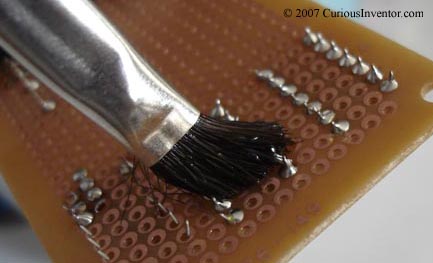Most manufacturers will clean off residues from any flux that isn’t labeled “no-clean,” despite flux datasheets like Kester’s that say even some of the more active fluxes do not need to be cleaned. For short life-span hobby projects, it probably doesn’t matter unless you’re using a solder/flux labeled “organic” or “water-soluble”–these fluxes leave behind very aggressive acids that will quickly eat away circuits. Cleaning may be necessary if you’re applying a protective coating that won’t adhere to flux residues. Finally, some rosin residues are tacky and may attract dust that can short a circuit.
The fact that a flux is made from rosin doesn’t tell you much about how strong it is or whether it should be cleaned. What matters is how concentrated the mix is and how much acidic (halides) activators were added. RadioShack® doesn’t supply any information on the flux in their standard rosin-cored solder, but it’s probably weak enough that the residues do not need to be cleaned off.
Isopropyl alcohol works decently on rosin-based residues, but clean shortly after soldering because the residues quickly harden. Use water for water-soluble fluxes. This pump containing bottle dispenses a little alcohol when you push down on the top with a brush, and keeps the rest from evaporating. If you are going to clean, make sure you wipe up the remnants with a lint-free cloth–don’t just spread them around the board with a brush and alcohol.


